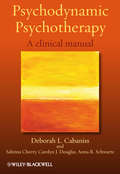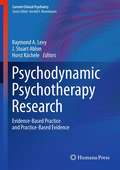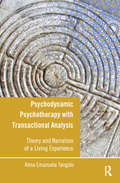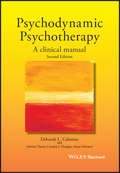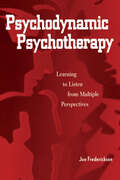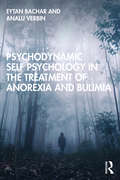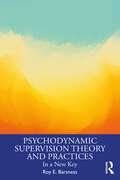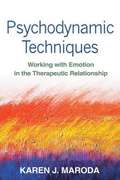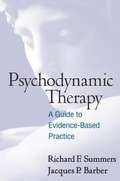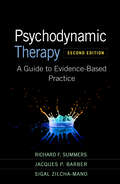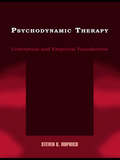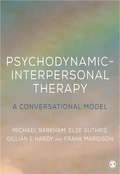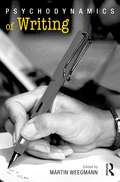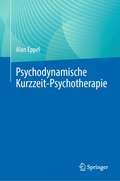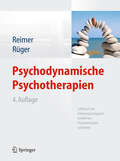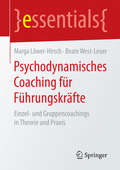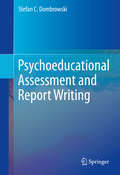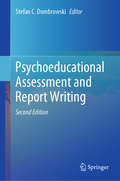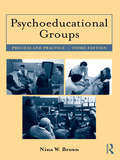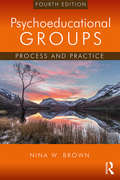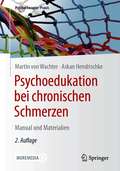- Table View
- List View
Psychodynamic Psychotherapy
by Anna R. Schwartz Sabrina Cherry Deborah L. Cabaniss Carolyn J. DouglasPsychodynamic psychotherapy offers people a chance to create new ways of thinking and behaving in order to improve the quality of their lives.This book offers a practical, step-by-step guide to the technique of psychodynamic psychotherapy, with instruction on listening, reflecting, and intervening. It will systematically take the reader from evaluation to termination using straightforward language and carefully annotated examples. Written by experienced educators and based on a tried and tested syllabus, this book provides clinically relevant and accessible aspects of theories of treatment processes. The workbook style exercises in this book allow readers to practice what they learn in each section and more "actively" learn as they read the book.This book will teach you:About psychodynamic psychotherapy and some of the ways it is hypothesized to workHow to evaluate patients for psychodynamic psychotherapy, including assessment of ego function and defensesThe essentials for beginning the treatment, including fostering the therapeutic alliance, setting the frame, and setting goalsA systematic way for listening to patients, reflecting on what you've heard, and making choices about how and what to sayHow to apply the Listen/Reflect/Intervene method to the essential elements of psychodynamic techniqueHow these techniques are used to address problems with self esteem, relationships with others, characteristic ways of adapting, and other ego functionsWays in which technique shifts over timeThis book presents complex concepts in a clear way that will be approachable for all readers. It is an invaluable guide for psychiatry residents, psychology students, and social work students, but also offers practicing clinicians in these areas a new way to think about psychodynamic psychotherapy. The practical approach and guided exercises make this an exceptional tool for psychotherapy educators teaching all levels of learners.This book includes a companion website: www.wiley.com/go/cabaniss/psychotherapywith the "Listening Exercise" for Chapter 16 (Learning to Listen). This is a short recording that will help the reader to learn about different ways we listen.Praise for Psychodynamic Psychotherapy: A Clinical Manual"This book has a more practical, hands-on, active learning approach than existing books on psychodynamic therapy."Bob Bornstein, co-editor of Principles of Psychotherapy; Adelphi University, NY"Well-written, concise and crystal clear for any clinician who wishes to understand and practice psychodynamic psychotherapy. Full of real-world clinical vignettes, jargon-free and useful in understanding how to assess, introduce and begin psychotherapy with a patient. Extraordinarily practical with numerous examples of how to listen to and talk with patients while retaining a sophistication about the complexity of the therapeutic interaction. My trainees have said that this book finally allowed them to understand what psychodynamic psychotherapy is all about!"--Debra Katz, Vice Chair for Education at the University of Kentucky and Director of Psychiatry Residency Training"This volume offers a comprehensive learning guide for psychodynamic psychotherapy training."--Robert Glick, Professor, Columbia University(Cover painting by Nicki Averill)
Psychodynamic Psychotherapy Research
by J. Stuart Ablon Raymond A. Levy Horst KächelePsychodynamic Psychotherapy Research: Evidence-Based Practice and Practice-Based Evidence continues the important work of the first book published in 2009 by Humana Press (Handbook of Evidence-Based Psychodynamic Psychotherapy: Bridging the Gap Between Science and Practice). This landmark title presents in one volume significant developments in research, including neuroscience research, in psychodynamic psychotherapy by a team of renowned clinician-researchers. The demand for ongoing research initiatives in psychodynamic psychotherapy from both internal and external sources has increased markedly in recent years, and this volume continues to demonstrate the efficacy and effectiveness of a psychodynamic approach to psychotherapeutic interventions in the treatment of psychological problems. The work in this volume is presented in the spirit of ongoing discussion between researchers and clinicians about the value of specific approaches to specific patients with specific psychiatric and psychological problems. Multiple forms of treatment interventions have been developed over the past fifty years, and this volume makes clear, with firm evidence, the authors' support for the current emphasis on personalized medicine. Groundbreaking and a major contribution to the psychiatric and psychologic literature, Psychodynamic Psychotherapy Research: Evidence-Based Practice and Practice-Based Evidence provides firm grounding for advancing psychodynamic psychotherapy as a treatment paradigm.
Psychodynamic Psychotherapy in South Africa: Contexts, theories and applications
by Cora Smith, Glenys Lobban and Michael O’LoughlinAn accessible text for practitioners, students, and non-specialists about the practice of psychotherapy in South Africa.Psychoanalysis as a long term modality is inaccessible to the average South African. In this book the authors describe how psychoanalytically orientated or psychodynamic psychotherapy can be practiced as a short-term endeavour and applied to contemporary issues facing the country. Psychodynamic work is currently undertaken by clinical psychologists, therapists, clinicians, trainers, teachers, clinical supervisors, consultants and researchers working in university settings, state hospitals, community projects, private practice and research. The debates, clinical issues, therapeutic practice and nature of research covered in the book are widely representative of the work being done in the country. The need for shorter term therapy models and evidence-based interventions is as acute in global practice as it is locally. The lessons learned in South Africa have broader implications for international practitioners, and the authors stress the potential inherent in psychoanalytic theory and technique to tackle the complex problems faced in all places and settings characterised by increasing globalisation and dislocation. The book is structured in three main sections. Psychodynamic Psychotherapy in South Africa is aimed at local and international practitioners and students, while non-specialist readers will find the text informative and accessible.
Psychodynamic Psychotherapy with Transactional Analysis: Theory and Narration of a Living Experience
by Anna Emanuela TangoloThe main values and principles of Transactional Analysis, in its original psychodynamic matrix, become a concrete experience in this book thanks to the accurate description of the daily practice of a long-experienced therapist: Anna Emanuela Tangolo. Analyzing several cases, the author examines the clinical tools of Berne's group therapy and the analysis of dreams, without however neglecting other important aspects such as preparing the setting or leading an interview. Particular relevance is given to the therapeutic relationship, seen as the interweaving of an experience in order to send stimuli to the patient so as to re-structure his or her intrapsychic world through rigorous and precise inputs, analysable in linguistic sequences. This book is meant not only for those who study psychotherapy, but also for anyone who wants to learn about clinical TA and its functioning.
Psychodynamic Psychotherapy: A Clinical Manual
by Anna R. Schwartz Sabrina Cherry Deborah L. Cabaniss Carolyn J. DouglasAn updated and expanded new edition of a widely-used guide to the theory and practice of psychodynamic psychotherapy, providing material for readers to apply immediately in their treatment of patients. Built around a unique and proven approach that clearly teaches psychodynamic psychotherapy using three key steps - listening, reflecting, and intervening Features new and expanded workbook-style exercises across all chapters, helping readers to translate what they are learning into real-world practice with patients Offers a comprehensive learning guide for psychodynamic therapy based on a proven syllabus for trainees in psychiatry, psychology, social work, medicine, nursing, and psychoanalysis A clear and comprehensive teaching text, now supported by a brand new educators' guide to assist teachers and program directors in making best use of the material in training programs
Psychodynamic Psychotherapy: Learning to Listen from Multiple Perspectives
by Jon FredericksonFirst published in 1999. Routledge is an imprint of Taylor & Francis, an informa company.
Psychodynamic Self Psychology in the Treatment of Anorexia and Bulimia
by Eytan Bachar Analu VerbinThis book presents an implementation of psychodynamic self psychology in the treatment of anorexia nervosa and bulimia nervosa, using a theoretical and therapeutic approach to examine the way that patients turn to food consumption or avoidance in order to supply needs they do not believe can be provided by human beings. The book starts with an overview of self psychology, presenting both the theory of self psychology and its specific application for the etiology and treatment of eating disorders. Featuring contributions from eating disorder professionals, the book then integrates this theory with 16 compelling case studies to explore how the eating-disordered patient is scared to take up space in a society that encourages precisely that. Professionals in the field of psychotherapy for eating disorders, as well as the entire community of psychotherapists, will benefit from the empirical capability of the theory to predict the development as well as remission from eating disorders.
Psychodynamic Supervision Theory and Practices: In a New Key
by Roy E. BarsnessThis book sets out a new model for psychodynamic supervision, designed around relational psychoanalytic theory and practice. It emphasizes the development of the self of the therapist and working directly with the emergent therapeutic relationship. Building on Barsness’s seminal Core Competencies of Relational Psychoanalysis text, this book is grounded in those theoretical competencies. The author offers what he calls the MAMAL method of supervision—(M—muse; A—affect; M—metabolization; A—articulation; and L—learning), a method that privileges (1) affect over cognition, (2) the use of the therapist’s subjectivity as the primary portal to the patient’s internal and interpersonal world, (3) the immersion of the supervisor’s subjectivity in the supervisory process, and (4) viewing the patient as a muse rather than an object of assessment. The MAMAL method approach enriches the supervisory experience and enhances the therapeutic process, fostering a therapeutic climate where both therapist and patient can thrive. It is attention to our own humanity and woundedness that facilitates a deep connection to our patients and animates the progression of the therapeutic process and is at the core of this supervision model.Drawing on clinical experience, this book is grounded in research and is a readable resource for psychoanalysts, psychotherapists, and mental health professionals, providing a clear guide to a relational model of supervision and a concise understanding of relational theory and practice.
Psychodynamic Techniques
by Nancy Mcwilliams Karen MarodaHelping therapists navigate the complexities of emotional interactions with clients, this book provides practical clinical guidelines. Master clinician Karen J. Maroda adds an important dimension to the psychodynamic literature by exploring the role of both clients' and therapists' emotional experiences in the process of therapy. The book discusses how to become more attuned to one's own experience of a client; offer direct feedback and self-disclosure in the service of treatment goals; and manage intense feelings and conflict in the relationship. Specific techniques are illustrated with vivid case examples. Maroda clearly distinguishes between therapeutic and nontherapeutic ways to work with emotion in this candid and instructive guide.
Psychodynamic Therapy
by Jacques Barber Richard SummersPresenting a pragmatic, evidence-based approach to conducting psychodynamic therapy, this engaging guide is firmly grounded in contemporary clinical practice and research. The book reflects an openness to new influences on dynamic technique, such as cognitive-behavioral therapy and positive psychology. It offers a fresh understanding of the most common problems for which patients seek help depression, obsessionality, low self-esteem, fear of abandonment, panic, and trauma and shows how to organize and deliver effective psychodynamic interventions. Extensive case material illustrates each stage of therapy, from engagement to termination. Special topics include ways to integrate individual treatment with psychopharmacology and with couple or family work.
Psychodynamic Therapy: A Guide to Evidence-Based Practice
by Richard F. Summers Jacques P. Barber Sigal Zilcha-ManoFirmly grounded in contemporary clinical practice and research, this pragmatic guide for professionals and students is now in a revised and expanded second edition. The book explains the theory underlying psychodynamic approaches and lays out a model for understanding psychopathology. Vivid case examples demonstrate how to tailor psychodynamic therapy effectively for individual patients. The authors provide a framework for diagnosing the patient&’s core psychodynamic problem and engaging the most useful mechanisms of change, using an integrative approach. Special topics include remote and hybrid treatment, combining therapy with psychopharmacology, and working with couples and families. New to This Edition *Incorporates cutting-edge research on psychotherapy process and mechanisms of change. *Chapter on telepsychotherapy, including clear recommendations for practice. *More attention to the social determinants of health--the psychic effects of adversity and various forms of oppression. *New and revised case examples, with diversity in age, gender, race, culture, and sexual identity. See also Practicing Psychodynamic Therapy: A Casebook, edited by Summers and Barber, which features 12 in-depth cases that explicitly illustrate the approach in this book.
Psychodynamic Therapy: Conceptual and Empirical Foundations
by Steven K. HuprichPsychodynamic Therapy reintroduces psychoanalytic and psychodynamic theory to the practice of clinical psychology in ways that are easily understandable, practical, and immediate in their application. Huprich readily demonstrates that, contrary to what is misconstrued and taught as relic and historical artifact, Sigmund Freud’s ideas and their evolution offer a comprehensive, useful framework from which clinical psychology and psychiatry can benefit. There are more theories and approaches to psychotherapy today than ever before. Psychodynamic Therapy attests to the fact that psychoanalytic and psychodynamic theory has more to offer clinicians and patients than any other theory. Through this book, readers will gain a greater appreciation for what psychodynamic theory offers and how they may apply these ideas toward effective clinical practice.
Psychodynamic-Interpersonal Therapy: A Conversational Model
by Else Guthrie Frank Margison Professor Gillian E. Hardy Professor Michael BarkhamThis book presents for the first time, a practical manual for psychodynamic-interpersonal therapy. Drawing on forty years of research, teaching and practice, its expert authors guide you through the conversational model's theory, skills and implications for practice. Part I sets out the model's underlying theory and outlines the evidence for its efficacy with client groups. Part II guides you through clinical skills of the model, from foundational to advanced. Part III offers practical guidance on implementing the approach within a range of settings, and for developing effective practice through reflection and supervision.
Psychodynamic-Interpersonal Therapy: A Conversational Model
by Else Guthrie Frank Margison Professor Gillian E. Hardy Michael BarkhamThis book presents for the first time, a practical manual for psychodynamic-interpersonal therapy. Drawing on forty years of research, teaching and practice, its expert authors guide you through the conversational model’s theory, skills and implications for practice. Part I sets out the model’s underlying theory and outlines the evidence for its efficacy with client groups. Part II guides you through clinical skills of the model, from foundational to advanced. Part III offers practical guidance on implementing the approach within a range of settings, and for developing effective practice through reflection and supervision.
Psychodynamics of Writing
by Martin WeegmannPsychoanalysis is often referred to a talking cure, but in this fascinating book it is the art of writing that is discussed and explored. Including contributions from a selection of leading therapists, the book shines a psychoanalytic light on the very process through which the discipline is described. It includes chapters on the idea of creativity, the issues around a therapist’s subjectivity, the challenges of describing trauma, as well as those of co-authorship. Psychodynamics of Writing will appeal to clinicians, therapists and anyone interested in what the process of writing means.
Psychodynamische Kurzzeit-Psychotherapie
by Alan EppelDieses Buch ist ein benutzerfreundlicher Leitfaden zur psychodynamischen Kurzzeit-Psychotherapie für Berufsanfänger und Studenten der Psychiatrie. Dieses Buch wurde von einem erfahrenen Psychiatriepädagogen geschrieben und sorgfältig auf Klarheit und Prägnanz hin konzipiert, um eine qualitativ hochwertige Ausbildung und Praxis zu ermöglichen. In einer leserfreundlichen Sprache beginnt der Text mit einer Einführung in die theoretischen Grundlagen der psychodynamischen Psychotherapie. Zu den Themen gehören die Prinzipien der Bindungstheorie, die duale Systemtheorie der Emotionsverarbeitung, die Entscheidungstheorie, die Wahlpunktanalyse und ein kritischer Überblick über die Forschungsliteratur. Der Schwerpunkt des Buches liegt dann auf der Beschreibung der Ziele und Aufgaben der einzelnen Therapiephasen im Rahmen der Einführungs-, der Emotionsverarbeitungs- und der Beendigungsphase in einem manualisierten Format. Das Buch schließt mit einem Kapitel über psychodynamisch informierte klinische Praxis für Nicht-Psychotherapeuten.Die psychodynamische Kurzzeit-Psychotherapie ist das ultimative Werkzeug für die Ausbildung von Studenten, Assistenzärzten, Praktikanten und Stipendiaten in der Psychiatrie, Psychologie, Beratung, Sozialarbeit und allen anderen klinischen Berufen der psychischen Gesundheit.
Psychodynamische Psychotherapien
by Ulrich Rüger Christian ReimerMit Focus auf das Wesentliche vermitteln die Autoren die tiefenpsychologischen Psychotherapieverfahren und berücksichtigen dafür aktuelle wissenschaftliche Studien. Der Band gliedert sich in die drei Teile Grundlagen, Verfahren und Störungen und enthält praxisbezogene Psychotherapiebehandlungspläne. Die Neuauflage wurde um Kapitel zur Ausbildungssituation in der Psychotherapie, zu Kostenträgern und zu gesetzlichen Rahmenbedingungen ergänzt.
Psychodynamisches Coaching für Führungskräfte: Einzel- und Gruppencoachings in Theorie und Praxis (essentials)
by Beate West-Leuer Marga Löwer-HirschDieses essential bietet Einblicke in die Praxis des psychodynamischen Leadership-Coaching, welche gestützt werden durch authentische Beispiele aus der Beratungspraxis der Autorinnen. Die Kernkompetenzen des Führens werden von unbewussten Dynamiken gesteuert. In der Beziehung zum Coach können diese entdeckt und integriert werden. Der innere Handlungsspielraum erweitert sich, sowohl im psychodynamischen Einzel- wie auch im Gruppencoaching auf je unterschiedliche Weise.
Psychoeducation Manual for Bipolar Disorder
by Jan Scott Francesc Colom Eduard VietaAlthough the mainstay of bipolar therapy is drug treatment, psychoeducation is a technique that has proven to be very effective as an add-on to medication, helping to reduce the number of all types of bipolar recurrences and hospitalization. The object is to improve patients' understanding of the disorder and therefore their adherence to pharmacotherapy. Based on the highly successful, evidence-based Barcelona program, this book is a pragmatic, therapists' guide for how to implement psychoeducation for bipolar patients. It gives practical guidance for how to conduct a psychoeducation group, using sessions and cases drawn from the Barcelona Psychoeducation Program. Moreover, it provides the reader with a great amount of practical tips and tricks and specific techniques to maximize the benefits of bipolar psychoeducation. The authors formed the first group to show the efficacy of psychoeducation as a maintenance treatment and have a long history of performing bipolar psychoeducation.
Psychoeducational Assessment and Report Writing
by Stefan C. DombrowskiThis textbook provides in-depth instruction for conducting psychoeducational assessments of children in grades K-12 and conveying results through detailed, well-written reports. It takes readers step by step through the assessment process - collecting data, writing reports, and communicating conclusions - for students with conditions spanning the range of IDEA classifications such as autism, learning disabilities, emotional disturbances, and conditions covered by Section 504. The book offers not only a broad understanding of assessment and communication skills, but also of the ethical, legal, cultural, and professional considerations that come with psychoeducational evaluation. And its sample reports model clear, well-organized results accessible to parents and caregivers as well as teachers and colleagues. Key areas of coverage include: * Assessment basics: the testing environment and protocols, interviewing, and observation. * Report writing section by section, from reason for referral to summary and recommendations. * Guidelines for oral reporting, with case examples. * Special issues in psychoeducational assessment and report writing. * Sample psychoeducational reports using this framework. Psychoeducational Assessment and Report Writing is an essential text for graduate students, researchers, professors, and professionals in child and school psychology; assessment, testing, and evaluation; social work; and psychological methods/evaluation.
Psychoeducational Assessment and Report Writing
by Stefan C. DombrowskiThe second edition of this textbook provides expanded and updated guidance on the process of psychoeducational assessment and report writing for children in grades K-12. It casts the entire process within a newly proposed evidence-based psychoeducational assessment and report writing framework, and explains how to convey results through detailed, well-written reports. The new edition guides readers, step by step, through the assessment process – collecting data, writing reports, and communicating conclusions – for students with conditions spanning the range of IDEA classifications. Chapters offer a broad understanding of assessment and communication skills as well as the ethical, legal, cultural, and professional considerations that come with psychoeducational evaluation. In addition, chapters significantly expand on the coverage of learning disabilities, autism spectrum, intellectual disabilities, gifted, and other health-impaired and emotional disturbance assessment. The text updates sample reports from the previous edition, offering annotated commentary in the report explaining salient points and major decisions, and incorporates additional report samples to demonstrate fully the assessment and report writing process. Key topics addressed in the revised and expanded edition include: Psychoeducational assessment and report writing in school and clinic settings. Interview formats from various perspectives, including caregivers/parents, teachers, and students. Assessment of culturally and linguistically diverse youth. Assessment of social, emotional, behavioral and mental health difficulties that may affect students’ educational functioning. Common academic difficulties, including reading, writing and mathematics. Common recommendations and accommodations for behavioral, social, emotional, and learning needs. Incorporation of response-to-intervention/curriculum based assessment data into the psychoeducational report. Psychoeducational Assessment and Report Writing, 2nd Edition, is an essential textbook for graduate students as well as researchers, professors, and professionals in child and school psychology, educational assessment, testing, and evaluation, social work, and related disciplines.
Psychoeducational Assessment of Students Who Are Visually Impaired or Blind: Infancy Through High School
by Sharon Bradley-JohnsonDiscusses administering psychological tests to students who are blind.
Psychoeducational Groups: Process and Practice
by Nina W. BrownWith this third edition, Psychoeducational Groups remains the only comprehensive, user-friendly guide to planning, implementing, facilitating, and evaluating psychoeducational groups. It presents all the necessary information to prepare leaders of a psychoeducational group through group design and practice. Included are step-by-step guidelines on how to initiate group sessions, construct group objectives, engage group members, monitor progress, and establish evaluation and follow-up guidelines. Emphasis is placed on the personal growth and development of the group leader, with careful consideration given to increasing awareness of personal issues and the potential impact that a leader can have on the group. New to this edition are chapters on cultural and diversity factors; risk management and ethics; groups for relating and communication; and groups in educational, agency, and workplace settings.
Psychoeducational Groups: Process and Practice
by Nina W. BrownWith this 4th edition, Psychoeducational Groups remains the only comprehensive, user-friendly guide to planning, implementing, facilitating, and evaluating psychoeducational groups. The 4th edition expands the discussions about group leaders’ knowledge base, self-development, and techniques; best practices for group facilitation; and effective uses for group therapeutic factors. Substantial new material includes templates, scripts, and sample forms; suggestions for leader interventions for group and individual issues and difficulties; a social media policy; and the effectiveness of manualized and cyber/virtual groups.
Psychoedukation bei chronischen Schmerzen: Manual und Materialien (Psychotherapie: Praxis)
by Askan Hendrischke Martin von WachterDieses Buch stellt 12 psychoedukative Module zur Schulung im Einzel- und im Gruppensetting vor und gibt eine Fülle von Anregungen. Angesprochen sind ärztliche und psychologische Psychotherapeuten, schmerzmedizinisch tätige Ärzte, aber auch Physio- und Ergotherapeuten, Pflegekräfte oder Mitarbeiter im Bereich der Gesundheitsförderung. Nach einer Einführung zur Psychoedukation gehen die erfahrenen Autoren Schritt für Schritt auf verschiedene Schmerzerkrankungen ein. – Voraussetzung für eine aktive Teilnahme der Patienten an einer erfolgreichen Schmerztherapie ist die Kenntnis über Ursachen, Sinn der Behandlung und ihrer Therapiebausteine sowie über das Zusammenwirken körperlicher, psychischer und sozialer Krankheitsfaktoren. Aus dem Inhalt: Support durch Übungen, Arbeitsblätter und Präsentationsfolien zum Download. Edukationsfilme, Selbsthilfeliteratur, Apps und Internetlinks werden vorgestellt. Auf eine Einbeziehung der Angehörigen und der Selbsthilfe wird ausführlich eingegangen. Für Problemsituationen bietet das Buch umfangreiche Hilfestellungen, die sich bewährt haben. Die Autoren: Dr. med. Martin von Wachter, Facharzt für Psychosomatik mit Zusatzausbildung in psychosomatischer Schmerztherapie (IGPS), Ltd. Arzt der Sektion Schmerztherapie der Klinik für Psychosomatik am Ostalb-Klinikum Aalen. Supervisor für Schmerzpsychotherapie. Dr. med. Askan Hendrischke, Facharzt für Psychosomatik, Facharzt für Allgemeinmedizin. Lehrender Therapeut für Systemische Therapie.
